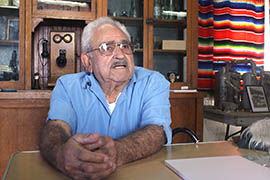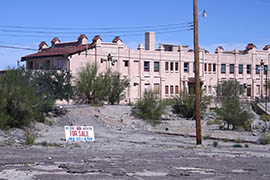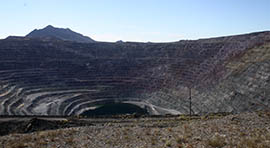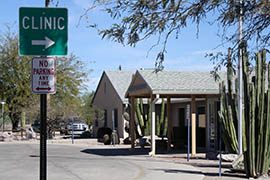Cronkite News has moved to a new home at cronkitenews.azpbs.org. Use this site to search archives from 2011 to May 2015. You can search the new site for current stories.
State Health Assessment highlights rural communities needing more care
AJO – Jose Castillo was born here in 1939, at the old hospital that sits atop a hill. He’s lived here most of his life and worked at the open-pit copper mine that used to employ much of the town.
But when Castillo went into cardiac arrest in 2007, he had to be airlifted to Phoenix because Ajo doesn’t have a 24-hour hospital. He has to travel about 100 miles to Phoenix a few times a year to see a heart specialist and primary care doctor.
As he ages, he’s realizing that Ajo’s health system might not be able to support him.
“It’s kind of a hardship because you don’t have enough doctors or medical people for everybody,” Castillo said. “You need doctors. If there’s no doctors, what are you going to do?”
Arizona’s first State Health Assessment listed Ajo among communities with the highest health risk outside of the Phoenix and Tucson metro areas. Conducted by the Arizona Department of Health Services, the assessment considered factors such as access to health care facilities and professionals, maternal care, mortality and environmental health.
“It’s not a surprise,” said Fran Driver, CEO of Desert Senita Community Health, the only health center serving this community of 3,300. “If you want physical therapy or you just want variety or options, you just don’t have that choice here.”
Will Humble, director of the Arizona Department of Health Services, said the assessment will help his team make decisions on health care services around the state.
“One of our tasks is to help identify those areas that are in most need and put together evidence-based health outcomes that are targeted so we pick and choose the areas we’re likely to be most effective,” Humble said.
The list of services one can’t get in Ajo is long: no prenatal care, no specialty doctors, no nursing home, no home-health nurses, no physical therapy. Desert Senita now has the only pharmacy in town after the owner of the other pharmacy retired.
The health center does have a lab on site, but insurance regulations dictate what kind of tests it can do, according to Carlos Yanez, lab technician at Desert Senita.
“We’re probably sending out anywhere from 30 to 40 percent of the testing that we could be doing here,” Yanez said. “It’s a big chunk, especially when you have a patient that’s actually currently ill with a fever, they need some sort of answer by the end of the day.”
The lab often has to send patients or lab work to Phoenix or Tucson – 130 miles away – to be tested, Yanez said.
“If you ask an elderly person to go get their blood drawn in the city, you’re adding four hours to their day to just get blood drawn,” he said. “That doesn’t include the wait time.”
With an aging population and a median age of 51 in Ajo, that lack of care can be challenging, Castillo said.
“It’d be nice to have a hospital 24 hours here, but we don’t have one,” he said. “So if you’re going to get sick, you better get sick between 9 and 5, otherwise you’re off to Phoenix anyway.”
When the 1,100-foot-deep New Cornelia mine was at its peak, the hospital, which is now for sale, had plenty of doctors and even two surgeons, Castillo said. But when the mine closed in 1983, most of the population – and those doctors and surgeons – went with it.
“I think Ajo is one of those forgotten places,” said Driver, with Desert Senita Community Health. “We’re 10 miles south of Maricopa County and we’re the most western edge of Pima County. Services don’t tend to make it out here. It’s two hours to drive from anywhere.”
And it’s also hard to persuade medical professionals to move to Ajo, where the closest Wal-Mart is 85 miles away, she said.
“I see the jewel that Ajo is and the population that we serve,” Driver said, “and I just know that if people would come here and see that, they would fall in love with it too. If we could just convince people that it’s OK to have a slower life, without all that noise, they would love Ajo too.”
Debbie Weber, Pima County Health Department’s nurse manager for the Ajo area, said a public health nurse visits quarterly to do immunizations. Other than that, the county doesn’t provide too many services for Ajo, she said.
“It’s sad,” she said. “It would be nice if there was more medical care available there. You have to helicopter people out if something seriously goes wrong, so it puts you more at risk to live there because you might not be able to get to adequate care in time.”
And that risk of living in Ajo can get worse as its residents age, she said.
“If you get old in Ajo, you hope that you can stay in your home,” Weber said. “And there really aren’t any other options. You’d have to move. That’s pretty sad because that’s your home.”
Castillo, who turns 75 in April, said he’ll stay in his home as long as his health allows it.
“I was born here, I’m going to stay here,” he said. “I’ll just stay here til I can’t do anything – then maybe my kids will ship me off someplace else. But while I’ve got control of my functions, I’ll just stay here.”











